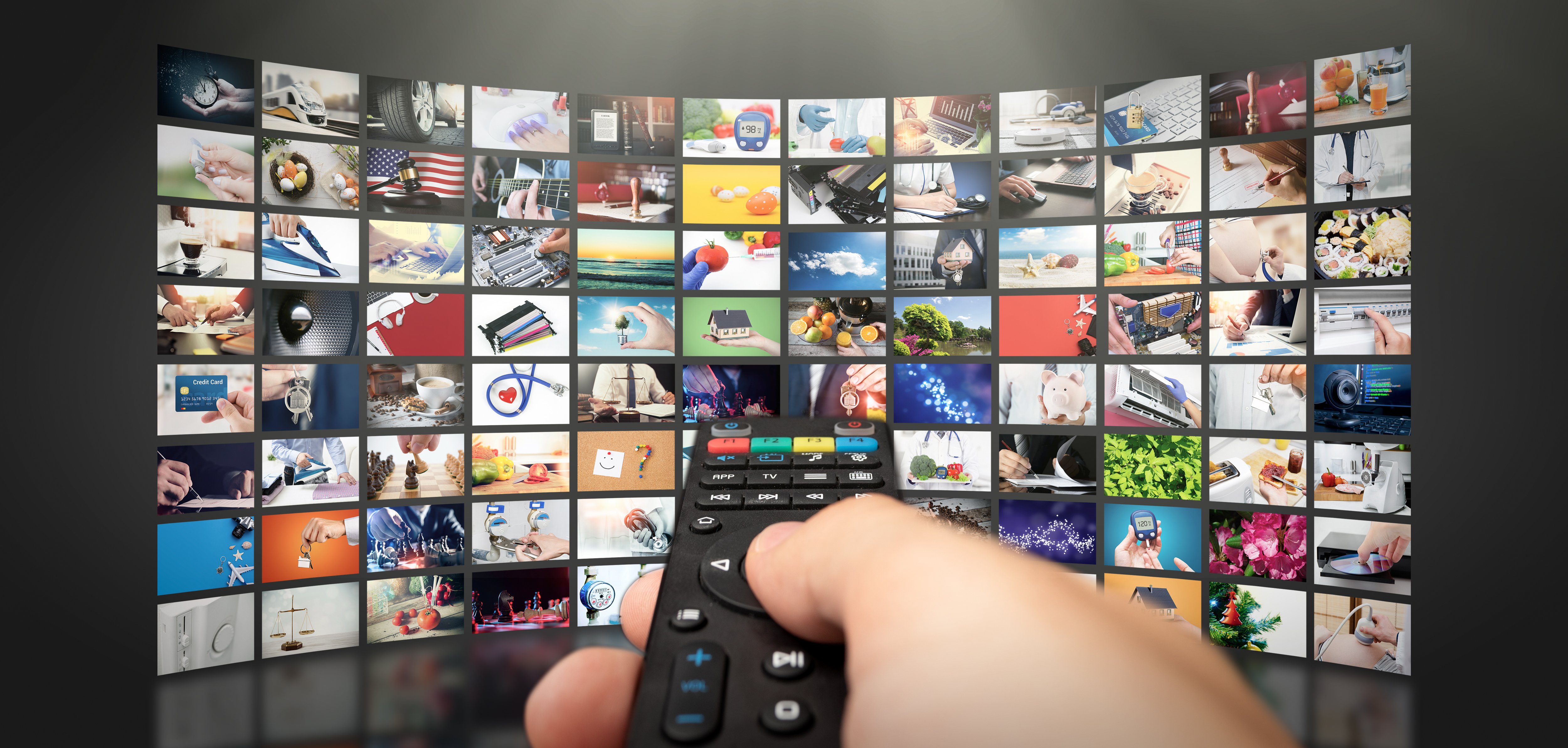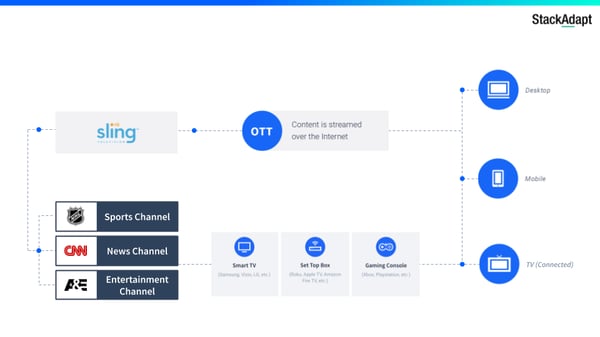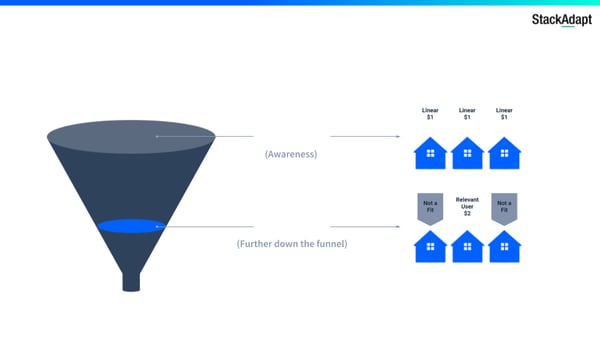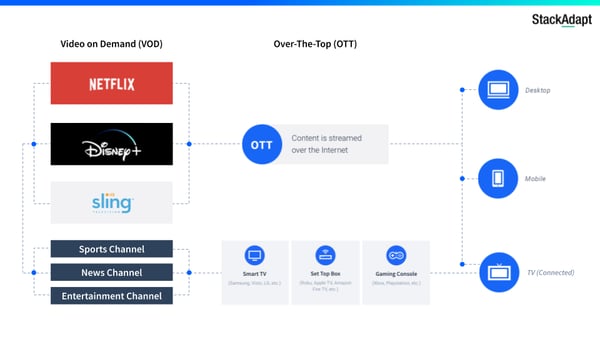

Over-the-top (OTT) advertising has exploded in popularity as more consumers are shifting their attention away from traditional television to digital channels.
Historically, video content has been delivered to consumers via a set-top box to a TV—transacted through a closed ecosystem called the multichannel video programming distributor (MVPD), such as Comcast or DirecTV. Although this was once the norm, more consumers are abandoning their paid, linear TV subscriptions for those available over the internet.
As this number of cord-cutters and cord-nevers continues to rise, the need for OTT advertising also increases. Marketers need to keep up with this shifting trend in video consumption.
In order to understand what OTT advertising is, we must first tackle OTT content, where the advertising placements are. OTT programming encompasses all content that is streamed over the internet and does not require a subscription to a traditional cable or pay-TV service.
This content can be consumed on any device that connects to the internet, including connected TVs (CTV) such as smart TVs, set-top boxes, or gaming consoles. Devices also include desktop devices, such as computers or laptops and mobile smartphones.
As consumers have become increasingly comfortable with digital content streamed through their various devices, OTT programming has become the new norm. In particular, when content is streamed on connected TVs or set-top boxes, it provides the same viewing experience as linear TV would in the casual environment of a living room.
This is highly appealing to those looking for an alternative to their paid TV subscriptions and if advertisers can effectively match that TV watching experience, it is also favoured by viewers.

Now that we understand what the programming looks like, we can take a dive into what the ads look like. OTT advertising includes all digital ads that are shown during this streamed content. This form of digital advertising is becoming more widespread and entering media plans as an additional tactic to complement display, native and video advertising.
Much like these original digital channels, OTT ad placements can be bid on and purchased through a guaranteed media buy or through programmatic real-time bidding. A guaranteed media buy offers the advertiser a set price and impression number based on reach and frequency. This would be agreed upon in advance.
If an advertiser is looking to engage in programmatic buying through a demand-side platform (DSP), inventory is available and ad placement options are growing. The second option, buying OTT ad placements in the real-time bidding environment, has many benefits to advertisers including competitive pricing, control over data-driven targeting options, reporting and the ability to optimize in real-time.
Since OTT advertising is served over the internet, it offers many benefits to marketers looking to extend their reach in digital advertising. Much like display, native, and video advertising, OTT provides the opportunity for advertisers to leverage similar campaign setup and targeting as these other programmatic media buys. More importantly, it frees advertisers from the constraints of broadcasting schedules and TV ad pricing limitations.
For many advertisers, television is a much desired medium, but due to pricing and inventory availability, it is often not an option. OTT eliminates that barrier, providing the opportunity to access video streaming placements online. And of course, it's on trend with how and when viewers are consuming content, putting advertisers in a great position to reach prospects where they are viewing programming, and in most cases, when they are more willing to receive ads. Let’s dive into what this means for advertisers.
OTT ads are served digitally, so they can leverage the same audience targeting parameters as other programmatic campaigns. This includes layering targeting for audience demographics, interests and behaviours, location and even custom built audiences. Each of these targeting options are incredibly important for reaching your desired audience.
Why? It leads to relevance and eliminates waste. Ad spots are only bid on and purchased when a viewer matches your designated targeting parameters, meaning the audience is highly relevant. Creative messaging then appears in full-screen and in highly viewable environments, where they cannot be skipped, ultimately reducing the chances that your impressions are wasted.
As you are only bidding on relevant geolocations, the impressions are only served in households with that relevant audience. Running campaigns with OTT ads improve the ability to capture the right audience, enable greater budget efficiency, and limit the noise by excluding irrelevant viewers and households. Specifically with audience targeting, OTT allows advertisers to make a distinction between households and foster hyper-relevant content.
With linear TV, the same ad would be shown to all households tuning into the same channel, regardless of who was watching. In other words, linear TV follows a general contextual targeting model: airing ads on stations with relevant content. This can be seen as a fine upper funnel awareness tactic to reach all viewers of a specific channel. OTT, on the other hand, allows for audience targeting to take place on the individual household level and serves the appropriate ad accordingly, a great benefit for lower funnel advertising.

The difference between linear and OTT is that the people in Household A and C may not be interested in your product, while Household B is interested. OTT advertising improves efficiency by only serving the ads to Household B. It is still hard to know who exactly you're reaching within a household, but you know that someone who is watching content in that house is relevant.
Furthermore, since the ads that are served are much more relevant to the viewer, it results in increased engagement. If an ad is shown to someone who does not fit the criteria for the audience group, it is money wasted and the chances of that user engaging with the ad are significantly reduced. If the ad is shown to someone who can connect with the brand and the messaging, they are much more likely to engage with it.
OTT ads can be served programmatically, enabling advertisers to engage in real-time bidding auctions for ad placements. What this means is that they are able to bid at dynamic rates, increasing affordability. The affordability of OTT impressions in comparison to linear TV ads is not only a benefit, but as mentioned, it is actually a direct means for advertisers to enter the television advertising space.
Although more expensive than the average video or display ad, OTT ads are shown in the same environment as ads you would normally see during regular television programming. Compared to the average television commercial that can range anywhere from a few hundred dollars per ad, to several thousand dollars, an OTT ad can be purchased at much lower rates.
As you get more precise targeting and optimization opportunities with OTT, you are getting more bang for your buck! OTT also offers a means to advertise in major television programming, such as The Oscars or The Grammys, when the linear TV inventory spots are sold out.
Finally, often overlooked when discussing the benefits of OTT is campaign measurement and reporting. With linear TV, an advertiser would have to wait often weeks, maybe months, after programming and advertising was shown to receive any viewer metrics that would be available. Once the run is done, there are no changes that can be made to improve performance, whether it's targeting adjustments or other campaign optimizations.
OTT advertising is served digitally, meaning that marketers have access to real-time metrics, and can make immediate optimization decisions to increase the likelihood of campaign success. You can even measure campaign results related to website visits or online purchases, and also offline behavior. The ability to track the impact of your OTT campaigns with digital metrics, including video completion rates, as well as offline impact like increase of foot-fall traffic or in-store sales, is a great benefit of running on OTT.
Although OTT is a very effective channel to leverage on its own, for an extensive campaign strategy, you will want to appropriately integrate OTT in your media mix. Combining native, display, and video together is the traditional trifecta for your campaigns because it allows you to capture a relevant audience on all channels where they are found online.
Leveraging a strategic combination of these channels also enables advertisers to nurture prospects, playing to the strengths of each medium. It is recommended that you incorporate OTT with these tactics to get the best campaign results, as it broadens the scope of your digital strategy to yet another relevant channel. This will allow you to truly capture a relevant audience and keep them interested and engaged wherever they are online.
Television ads have been successful in the past because video ads are compelling, and a television was a common fixture in American households. Video ads are ideal to share lengthy visual messages with users and show a brand’s story with pictures and sound. Digital video ads are essentially an extension of this, in that you are showing a video ad to a targeted audience group. The difference? The type of content they are consuming when they see the ad.
Users may see a video ad when browsing the web, either on desktop or mobile, but they are not always in the frame of mind to be receiving and engaging with video ad content. With television and now OTT, the ads are shown within content that viewers are inherently more engaged with, they've chosen what they are watching. Of course you want to capture your users on all channels, but incorporating OTT will ensure you are increasing brand recognition in a medium where they are more receptive to paying attention.
Where OTT wins over linear TV the most is the personalization in the experience; viewers also decide when they are watching and how they are watching. The reason OTT is the new alternative to linear TV is that the choice in content consumption – the what, when, where, and how – is given to the viewer. All of this combined provides a more positive user experience, and therefore makes the viewer more receptive to the ads shown. Now combine that with high volume television events, and video advertisers are making strides in digital.
Many television viewers are beginning to cut their paid subscriptions from the traditional television programming providers. These are the cord-cutters of the world. There is also a large and growing number of viewers that have never had a subscription at all – the cord-nevers.
OTT provides a much-desired opportunity to reach this audience as they shift their attention online. This distinct group of viewers may only exist on OTT and cannot be reached via linear at all. Not only that, but this group is growing! As viewers see the benefit in shifting to digital from paid television subscriptions, there is a rising need for advertisers to leverage OTT and accommodate these new viewing habits.
Video on Demand (VOD) streaming services, such as Netflix, Disney+, and Sling may not have advertising opportunities available if it weren’t for OTT. Even though they may not have ads in all cases, they are only able to thrive with the use of OTT content and digital devices.

The main setback that advertisers face when encountering OTT content is gated services. Not all OTT service providers offer ad spots, and that’s where advertisers can sometimes struggle.
OTT video ads are non-skippable and highly viewable, allowing for a perfect advertising scenario, when made available. That is why it is important to work with the right digital partner that will provide access to the ad exchanges that will offer OTT ad placements, and ensure you are able to take advantage of all the benefits of OTT advertising.
OTT content streamed over the internet is the new norm. As viewers are continuing to shift their media habits online to an array of digital formats, it is imperative that advertisers respond with relevant advertising, strategically on the available channels. Capturing your viewers in the right place at the right time means identifying what devices they are using, and building a digital strategy that considers the strengths and nuances of each of them.
As much as consumers are browsing blogs, catching up on the news and shopping online, they are also watching video content. And as video content continues to extend its reach, there are growing advertising opportunities available. Advertisers need OTT because that’s where the viewership is, and we can only expect to see this shift in user attention to rise. OTT and streaming services are here to stay.
Implement a video advertising software solution today to get the most out of OTT and all of its components.
Christiana is the Digital Marketing Manager at
Print, television, Google, Facebook, Instagram, TikTok, email, video, audio, apps, websites -...
 by Soundarya Jayaraman
by Soundarya Jayaraman
It’s Monday morning and your alarm goes off on your phone.
 by Emily Malis Greathouse
by Emily Malis Greathouse
Volney B. Palmer may have been the first person to use the term “advertising agency” when he...
 by Daniella Alscher
by Daniella Alscher
Print, television, Google, Facebook, Instagram, TikTok, email, video, audio, apps, websites -...
 by Soundarya Jayaraman
by Soundarya Jayaraman
It’s Monday morning and your alarm goes off on your phone.
 by Emily Malis Greathouse
by Emily Malis Greathouse
Never miss a post.
Subscribe to keep your fingers on the tech pulse.



